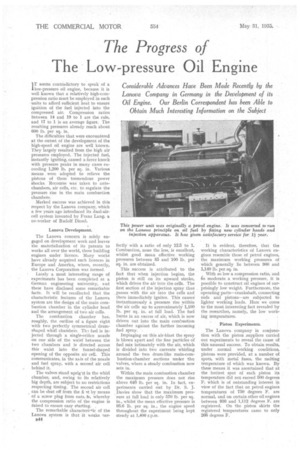The Progress of The Low-pressure Oil Engine
Page 62

If you've noticed an error in this article please click here to report it so we can fix it.
Considerable Advances Have Been Made Recently, by the Lanova Company in Germany in the Development of its Oil Engine. Our Berlin Correspondent has been Able to Obtain Much Interesting Information on the Subject
I T seems contradictory to speak of a low-pressure oil engine, because it is well known that a relatively high-compression ratio must be employed in such • units to afford sufficient heat to ensure ignition of the fuel injected into the compressed air. Compression ratios between 14 and 19 to 1 are the rule, and 17 to 1 is an average figure. The resulting pressures already reach about 600 lb. per sq. in.
The difficulties that were encountered at the outset of the development of the high-speed oil engine are well known. They largely resulted from the high air pressures employed. The injected fuel, instantly igniting, caused a fierce knock with pressure peaks in many cases exceeding 1,200 lb. per sq. in. Various means . were adopted to relieve the pistons of these tremendous power shocks. Peep:arse was 'taken to antechambers, air cells, etc. to regulate the pressure rise in the main combustion chambers.
Marked success was achieved in this respect by the Lanova company, which a few years ago introduced its dual-aircell system invented by Franz Lang, a co-worker of Rudolf Diesel.
Lanova Development.
The Lanova concern is solely engaged on development work and leaves the materialization of its patents to works all over the world, these building engines .under licence. Many works have already acquired such licences in Europe and America, where, recently, the Lanova Corporation was formed.
Lately a most interesting range of experiments has been completed at a German engineering university, and these have disclosed some remarkable facts. It will be recollected that the characteristic features of the Lanova system are the design of the main combustion chamber in the cylinder head and the arrangement of two air cells.
The combustion chamber has, roughly, the outline of a figure eight with two perfectly symmetrical drumshaped whifl chambers. The fuel is injected through a single-orifice nozzle on one side of the waist between the two chambers and is directed across this waist into the funnel-shaped opening of the opposite air cell. This communicates, in the al is of the nozzle and fuel spray, with a second air cell behind it.
The valves stand uprig'It in the whirl chamber, and, owing to its relatively big depth, are subject to no restrictions respecting timing. The second air cell can be shut off from the fi st by means of a screw ping from outs. le, whereby the compression ratio of the engine is faised to ensure easy starting.
The remarkable characterie+ic of the Lanova system is that it v,orks 7ierB44
fectly with a ratio of only 12.5 to 1. Combustion, none the less, is excellent, whilst good mean effective working pressures between 85 and "100 lb. per sq. in. are obtained.
This success is attributed to the fact that when injection begins, the piston is still on its upward stroke, which drives the air into the cells. The first section of the injection spray thus passes with the air into the cells and there immediately ignites. This causes' instantaneously a pressure rise within the air cells up to approximately 1,100 lb. per sq. in. at full load. The fuelburns in an excess of air, which is now driven out into the main combustion chamber against the further incoming fuel spray.
Impinging on this air-blast the spray is blown apart and the fine particles of fuel mix intimately with the air, which is divided into two currents whirling around the two drum-like main-combustion-chamber sections under thei valves, where a steady combustion now sets in.
Within the main combustion chamber the maximum pressure does not rise above 640 lb. per _sq. in. In fact, experiments carried out by Dr. S. J. Davies show that the maximum pressure at full load is only 570 lb. per sq. in., whilst the mean effective pressure is 95.6 lb. per sq. in., the engine speed throughout the experiment being kept steady at 1,400 r.p.m.
It is evident, therefore, that the working characteristics of Lanova engines resemble those of petrol engines, the maximum working pressures of which generally lie between 900 and 1,140 lb. per sq. in.
With so low a compression ratio, and moderate a working pressure, it is possible to construct oil engines of surprisingly low weight. Furthermore, the operating parts—crankshaft, connecting rods and pistons—are subjected to lighter working loads. Here we come to the most interesting fact revealed by the researches, namely, the low working temperatures.
Piston Experiments.
The Lanova company in conjunction with the piston suppliers carried out experiments to reveal the cause of this unusual success. To obtain results, under normal working conditions, pistons were provided, at a number of spots, with metal fuses, the melting temperature of which was known. By these means it was ascertained that at the hottest spot of each piston its temperature did not exceed 500 degrees F. which is of outstanding interest in view of the fact that on petrol engines temperatures of 750 degrees F. are normal, and on certain other oil engines between 930 and 1,112 degrees F. are registered. On the piston skirts the registered temperatures came to only 266 degrees F.




































































































